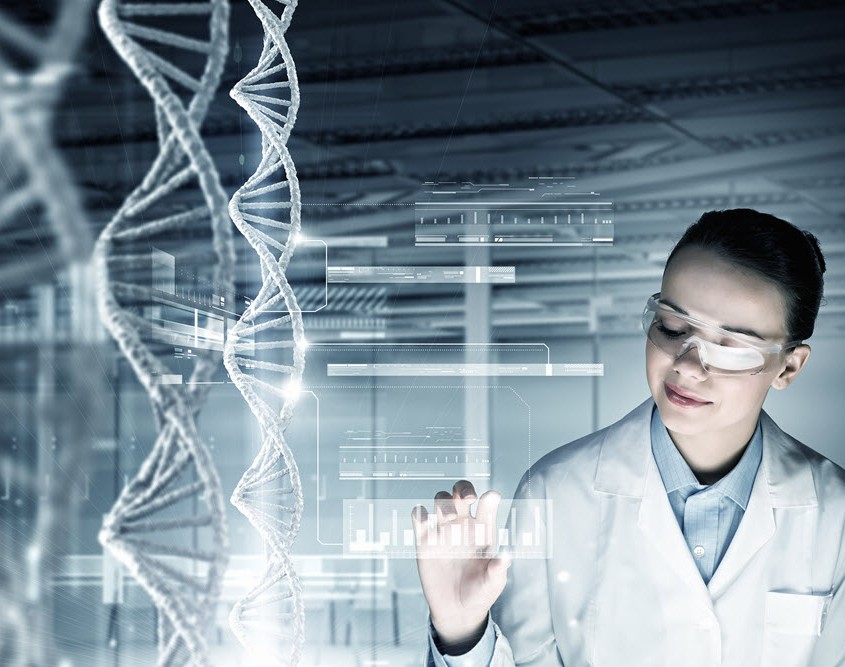Today’s laboratories are moving beyond point automation solutions, such as LIMS, ELNs, and robot-based HTS systems, to create “smart environments” that not only embrace the comfort and convenience needs of lab technicians but also help improve the consistency and reproducibility of experimental results.

If you asked laboratory professionals 15 years ago to describe their ideal modern “smart” laboratory, they would have mentioned some of the then cutting-edge data collection and automation tools just coming into widespread use, such as LIMS (Laboratory Information Management Systems), ELNs (Electronic Laboratory Notebooks), and Robotic HTS (High-Throughput Screening) systems for managing and testing cell culture plates.
How times have changed. In a world where self-driving car prototypes prowl our streets and smartphones let us communicate with our NEST thermostats and other home appliances, the idea of just what constitutes a smart lab has evolved as well.
Smart labs are no longer just about data management systems; the new trend is toward comprehensive “smart environments” that work quietly in the background to seamlessly embrace and support the needs of today’s lab professionals in order to help them become happier, healthier, and more productive in their jobs.
Unsure what we mean? Let’s take a look at a day in the life of today’s smart laboratories.
Around the Clock Laboratory Monitoring and Control, Even from Home
The day in the life of our smart laboratory actually starts overnight in one of the lab technician’s homes.
Custom laboratory apps, first demonstrated by the likes of IBM a dozen years ago, allow scientists and lab technicians to maintain control of experiments, using secure remote communication links.*
As a result, it’s no longer necessary to camp out in the lab overnight to turn lab equipment on or off – or to change a setting during an extended experiment. And, If anything goes awry, alarms will sound off on your PC at your desk and on the phone in your pocket.
Even “dumb” devices can be powered up or down remotely (by voice command if you like!) by utilizing smart outlets in your Formaspace lab workbench.
Personalized Security and Convenience Features Welcome You to the Lab
The sun is up. Now it’s time to make our way down to the lab.
Put on your smart glasses and use the iris scanner to open the secure door.
Once inside, Formaspace’s futuristic smart furniture will recognize your presence from a key fob with a built-in RFID sensor (or via a Bluetooth signal) and sets the height of your lab workbench to your preferred, ergonomically-ideal position. (Throughout the day, the lab bench will also remind you to get up and get moving – or to work from a standing position from time to time to increase your blood circulation.)
Just like in your kitchen at home, the coffeemaker in the kitchen mess will have already started brewing, having been alerted to your arrival in the parking lot. The lights are set to a comfortable level, and window shades turned just the right way to allow in natural light but shield your eyes from the glare of the morning sun. (No windows? No problem. Smart lights can bring sunlight into the lab if it doesn’t conflict with any of your experiments.)
And so it goes, right down the line. The temperature is set the way you like it (or perhaps the way cells in your test plates like it), your favorite music begins to play.
Now it’s time to get down to work.
Smart Laboratories Help Overcome Human Shortcomings, Improve Experimental Consistency and Repeatability
While the laboratory’s smart environment takes care of your personal comfort, it’s also designed to help overcome our shortcomings as human researchers.
How so? During your previous lab meetings, you’ve no doubt discussed the provocative article from Nature magazine that indicates we’re in a dark period of scientific research that’s been marred by a shockingly poor rate of experiment reproducibility. (The Nature article indicates that, when challenged, scientists can’t reproduce their own results more than half the time, and over 70% researchers can’t reproduce the results of experiments conducted by their colleagues in other laboratories.)
This points to a huge failure by the laboratory research community. But why is it happening? There are several theories. One thought is that humans are just really bad at performing the kind of repetitive tasks that commonly take place in laboratories. We get bored performing the same procedures and making the same observations over and over again, and as a result, we are simply not as accurate and consistent as we need to be in the long run.
Today’s Smart Laboratories: Taking a Step Beyond Electronic Laboratory Notebooks
That’s the theory of Charles Fracchia, an MIT Media Lab alumnus, and he wants to change things up as fast as possible.
A strong believer in the need to reduce human error and increase accuracy in data collection and interpretation, Fracchia has started his own biomedical research firm, Bosted-based BioBright, whose mission is to change laboratory culture from paper-based, hand-written notes to a souped-up, modern version of an ELN.
The BioBright concept is a fully electronic, self-writing documentation system that uses an advanced suite of software and communication tools, including video capture, voice commands, and open hardware communication channels that can document every detail of the scientific experiments taking place in your laboratory.
While earlier ELN initiatives were focused on capturing written data in a secure format so it could be shared across the origination, new initiatives, such as those promoted by Charles Fracchia of BioBright in the video above, utilize pervasive capture of video and other data recording channels to document the nuanced information necessary for consistent experiment reproducibility.
Friendly Robotic Assistance in Smart Lab Environments Helps Automate Repetitive Tasks
Aside from high-volume cell plate-based experiments, which have been successfully automated for years using robotic HTS systems, most laboratory experiments tend to be done in short runs or in small volumes that don’t easily lend themselves to automation.
However, that is starting to change.
Advances in computer-based manufacturing technology (referred to by Germans as the 4th Industrial Revolution) brought us new kinds of robots that are specifically designed to work side-by-side with humans (cobots). They are easy to program and can quickly pick up highly repetitious tasks in the laboratory that really aren’t suitable for humans to do consistently over the long run.
In the video above, a friendly robot, nicknamed “Andrew,” helps lab researchers by automating repetitious pipetting tasks. Other examples of laboratory automation solutions include the open source hardware products, such as PetriJet and NutriJet, which run on Arduino microcontrollers and Raspberry Pi microcomputers.
Smart Lab Environments Need to Carefully Control the Building Environment to Ensure Consistent Results
Thus far, we’ve talked about how to make lab experiments more consistent and reproducible by eliminating mistakes caused by human error.
But smart lab environments can also help measure (and hopefully prevent) errors introduced by anomalies due to environmental conditions as well.
Unwanted factors, such as excessive building vibration, electric power surges, and ESD discharges can wreak havoc with experiments, so the newest smart labs are equipped with advanced monitoring capabilities. For example, you can order Formaspace lab benches with built-in 24×7 accidental static discharge (ESD) monitoring as well as PDU control monitors on power outlets that let you condition the power supply, control the voltage, and monitor unexpected voltage spikes.

Maintaining a consistent, atmospheric environment is also critical for many operations. Not only does proper heat and humidity control keep lab workers comfortable and productive, maintaining proper airflow can be critical for a whole host of things, from preventing accidental exposure to chemicals to keeping culture specimens alive.
Despite some notable incidents, such the loss of 20 years of brain tissue specimens at a Harvard University Alzheimer’s research lab due to a freezer failure and a near miss due to a permafrost melting scare that threatened one of the world’s vital seed banks, the environmental climate control industry has really upped its game thanks to more sophisticated, computer-controlled air handling systems and automated fault detection diagnostics (FDD) systems.
Sound Interesting? Let’s Work Together
If you found this article interesting, then we’re interested to know more about you.
Are you ready to build a next-generation Smart Lab environment?
If so, let’s work on it together.
Here at Formaspace, we have experience working with some of the largest laboratory companies in the world, such as Dell and Ariosa Diagnostics. But we also work closely with start-up and educational facilities as well.
Either way, we custom build top-quality wet and dry lab furniture – just for you – at our Austin, Texas factory headquarters.

Want to learn more? Just take a moment to fill out our quick contact form below, and a Formaspace Laboratory Design Consultant will be in touch right away.












